By Nicki Richesin, The Children’s Book Review
Published: November 27, 2011
Angelica Shirley Carpenter is the author of many acclaimed biographies written for young people including Frances Hodgson Burnett: Beyond the Secret Garden, L. Frank Baum: Royal Historian of Oz, Robert Louis Stevenson: Finding Treasure Island, and Lewis Carroll: Through the Looking Glass. She also edited In the Garden: Essays in Honor of Frances Hodgson Burnett. Carpenter is the founding curator of the Arne Nixon Center for the Study of Children’s Literature at California State University in Fresno.
Nicki Richesin: Thank you for agreeing to do this interview. I know our readers will be fascinated by your writing life. You have established an impressive career as a biographer of many beloved and celebrated children’s book authors including Frances Hodgson Burnett, L. Frank Baum, Robert Louis Stevenson and Lewis Carroll. How did you first begin writing your books?
Angelica Shirley Carpenter: I began about 1988 when my mother Jean Shirley retired and moved from St. Louis to live near me in Palm Springs, Florida. Mother had already published several biographies for children and she arrived in Florida with a good idea for a new one, about Frances Hodgson Burnett. Oh, and she wanted us to write this together. In St. Louis Mother had found and read The One I Knew the Best of All, Frances’ autobiography of her childhood, and she thought that it would make a good starting point. I was running a small public library at this time, and I knew that children still read and loved The Secret Garden and A Little Princess, so I agreed that Frances would make a good subject. We established that the only biography of Frances Hodgson Burnett for young people had been written by her daughter-in-law in 1965. It lacked illustrations and, worse, it omitted certain incidents that were embarrassing to Frances’ family, like her divorce and remarriage. So we decided to write a more accurate account of her life and to try to publish it with photographs and illustrations from her books.
Your mother Jean Shirley was your co-author on three of your books. Could you tell us about her influence on your life and how you collaborated together?
Blog: The Children's Book Review (Login to Add to MyJacketFlap)
JacketFlap tags: Author Interviews, Jim Henson, Kathleen Krull, Biographies, Cultural Wisdom: Books that teach, Paul Brewer, Ages Four to Eight: Books for Pre-School Through Second Grade, Picture Books, Add a tag
By Nicki Richesin, The Children’s Book Review
Published: November 24, 2011
Kathleen Krull is an award-winning author of many, many children’s books, including most recently Jim Henson: The Guy Who Played With Puppets. She specializes in biographies written especially for children. Krull lives in San Diego with her husband Paul Brewer a children’s book illustrator. She once worked a part-time job at a library and was fired for reading too often. Now she can read to her heart’s content- all in the service of research for her wonderful books!
Nicki Richesin: Jim Henson: The Guy Who Played With Puppets is a brilliant depiction of a man loved by the world for his creative genius. I admired how you followed the trajectory of Henson’s career and the paintings captured the various eras- from his humble beginning in Mississippi to the sweet seventies clothes and hairstyles- to the man himself. What was your approach when telling the story of Mr. Henson’s life?
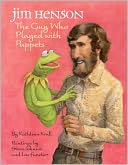 Kathleen Krull: Thanks for your kind words. I wanted to shed light on a person who has done so much for children, a modern-day hero, just unbelievably creative. In his early days, everyone wondered what he was doing, playing with puppets, but he grew into this brilliant magician at making people of all ages laugh.
Kathleen Krull: Thanks for your kind words. I wanted to shed light on a person who has done so much for children, a modern-day hero, just unbelievably creative. In his early days, everyone wondered what he was doing, playing with puppets, but he grew into this brilliant magician at making people of all ages laugh.
One of the many things I admired about your book is that you conveyed how Henson continued to pursue his dream of becoming a puppeteer, even when his father disapproved and even when his peers thought it was a little odd. Yet he stayed true to himself and his vision of what he wanted to achieve. I think this is such an important lesson for children, but really for everyone. I understand Henson’s children are running his company now. Do you think they’ve remained true to their father’s unique vision?
The family seems to be quite active in nourishing his reputation, as well as supporting new developments in puppetry with the Jim Henson Foundation, offering grants and other support.
Do you believe Henson’s work bringing Sesame Street to television programming for children revolutionized the way they learn?
I’m a bit past the Sesame Street target audience, but I well remember how progressive this show was when it premiered, how in tune with the spirit of the 60s and 70s. The idea that TV could be used as a force for good– wow– that laughter could help children learn– this was huge. It’s now the longest-running TV show for children ever, seen in more than 140 countries, so this is a major validation of his work.
At the end of the book, of cou
Add a CommentBlog: The Children's Book Review (Login to Add to MyJacketFlap)
JacketFlap tags: Picture Books, Author Interviews, Jewish Books, Biographies, Actors, Gloria Spielman, Janusz Korczak, Mime, Marcel Marceau, Ages Nine to Twelve: Books for Third Through Sixth Grade, Cultural Wisdom: Books that teach, Ages Four to Eight: Books for Pre-School Through Second Grade, Add a tag
By Bianca Schulze, The Children’s Book Review
Published: November 19, 2011
Gloria Spielman is the author of two picture books Janusz Korczak’s Children and Marcel Marceau: Master of Mime which has been awarded a Silver Medal in the 2011 Moonbeam Children’s Book Awards in the category of Non-Fiction Picture Book. A former high school English teacher, Gloria has also written English teaching books and contributed to multi-media English courses. She has many more wonderful books in the works that we can look forward to reading soon.
Nicki Richesin: Congratulations on your lovely Marcel Marceau: Master of Mime. It’s a beautifully compelling book about his legendary career and how he brought the world’s attention back to the ancient art of pantomime, but it’s also the story of how he survived World War II. What inspired you to create this well-deserved homage to Mr. Marceau?
Gloria Spielman: Thank You, Nicki. I always enjoy reading The Children’s Book Review; it’s such a terrific resource for anyone in the world of children’s books, so I was thrilled to talk to you.
I’d much rather tell you what inspired me to write my first book, Janusz Korczak’s Children, it’s a far better story. My then third grade daughter had to do a project on Korczak for Holocaust Memorial Day, and that got me reading and thinking.
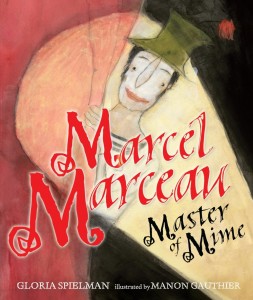 The truth is, the original inspiration for Marcel Marceau actually came from my friend Mandy. She was looking at Janusz Korczak and said “You know, you should write about Marcel Marceau. He was really interesting.” She told me of his work with the resistance and after she left I did some reading. Mandy was right. I started to imagine the pictures. I often imagine a picture book in pictures as well as words. My editor agreed. So did the publisher. And I started to write. I wish could say I saw a wonderful mime performance when I was a child and fell in love with it, but that would be a lie.
The truth is, the original inspiration for Marcel Marceau actually came from my friend Mandy. She was looking at Janusz Korczak and said “You know, you should write about Marcel Marceau. He was really interesting.” She told me of his work with the resistance and after she left I did some reading. Mandy was right. I started to imagine the pictures. I often imagine a picture book in pictures as well as words. My editor agreed. So did the publisher. And I started to write. I wish could say I saw a wonderful mime performance when I was a child and fell in love with it, but that would be a lie.
I was astonished to learn that Marceau was a part of the French resistance. He bravely smuggled Jewish children through the forests to safety and entertained allied troops. He led such a fascinating life. Did you discover anything that surprised you when doing your research?
It was all fascinating. But there is only so much that can go into a 32 page book. One anecdote that would have made a great picture book illustration is when Marceau came face to face with the man he called his creative father, Charlie Chaplin. He told Chaplin how he paid tribute to him in his American performance and began to imitate him in the middl
Add a CommentBlog: The Children's Book Review (Login to Add to MyJacketFlap)
JacketFlap tags: Picture Books, Art, Black History Month, Author Interviews, Artists, African American, Cultural Wisdom: Books that teach, Jeanne Walker Harvey, Elizabeth Zunon, Ages Four to Eight: Books for Pre-School Through Second Grade, Romare Bearden, Add a tag
By Nicki Richesin, The Children’s Book Review
Published: October 24, 2011
Jeanne Walker Harvey is the author of a fascinating new children’s book My Hands Sing the Blues which traces the childhood migration of young Romare Bearden as he leaves his grandparents in Charlotte, North Carolina and then moves to New York City to eventually become a great painter during the Harlem Renaissance. Her remarkable book is filled with striking collages and poetic, jazz-inspired lines that mimic perhaps what influenced Bearden most as an artist: his childhood home and music. Harvey is also the author of Astro the Steller Sea Lion and she blogs about children’s narrative nonfiction books at True Tales & A Cherry on Top. She lives in Marin County, California with her husband and an adorable black Lab who sleeps at her feet while she writes.
Nicki Richesin: Congratulations on your exquisite children’s book My Hands Sing the Blues. I fell in love with the dreamy artwork and your rhythmic poetic telling of Romare Bearden’s childhood story. I read that you were first inspired by Bearden’s paintings while working as a docent at the San Francisco Museum of Art. What about his artwork captivated you and moved you to create your book?
Jeanne Walker Havery: Thank you so much, Nicki, for your kind words. It’s truly been an amazing experience to be part of this creative journey. And I really appreciate the opportunity to be interviewed by you as I think The Children’s Book Review is a terrific site and resource for families, teachers, librarians AND writers!
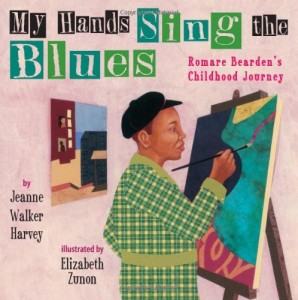 Yes, my docenting work at SFMOMA is exactly what inspired me to write this book. I was giving tours to school groups of the comprehensive Romare Bearden’s exhibit organized by The National Gallery when I fell in love with his art. As a teller of stories, I loved that his paintings told stories, especially the stories of his childhood in Charlotte, North Carolina. I found that I could hardly get the students to move on to the next painting in my tour because they were so engaged and drawn to his art, especially the huge vibrant collages. That’s when I decided that I would love to write a picture book about Bearden and the “people and the places” of his Charlotte childhood which he said was such an inspiration for his art.
Yes, my docenting work at SFMOMA is exactly what inspired me to write this book. I was giving tours to school groups of the comprehensive Romare Bearden’s exhibit organized by The National Gallery when I fell in love with his art. As a teller of stories, I loved that his paintings told stories, especially the stories of his childhood in Charlotte, North Carolina. I found that I could hardly get the students to move on to the next painting in my tour because they were so engaged and drawn to his art, especially the huge vibrant collages. That’s when I decided that I would love to write a picture book about Bearden and the “people and the places” of his Charlotte childhood which he said was such an inspiration for his art.
Although Romare Bearden worked in different media, how important was it to you that the illustrator Add a Comment
Blog: The Children's Book Review (Login to Add to MyJacketFlap)
JacketFlap tags: Folktales, Picture Books, Author Interviews, Bilingual Books, Latino, Author Showcase, Alma Flor Ada, Susan Guevara, Ages Nine to Twelve: Books for Third Through Sixth Grade, Cultural Wisdom: Books that teach, Hispanic Heritage, F. Isabel Campoy, Vivi Escriva, Ages Four to Eight: Books for Pre-School Through Second Grade, Felipe Dávalos, Leyla Torres, Add a tag
By Bianca Schulze, The Children’s Book Review
Published: September 30, 2011
F. Isabel Campoy is a scholar devoted to the study of language acquisition. She is a well-known author of numerous children’s books in the areas of poetry, theatre, folktales, biographies, and art. She is the recipient of many notable awards, including the Reading the World Award 2004, for “Cuentos que contaban nuestras abuelitas;” and the Junior Library Guild Premier Selection Award, 2006.
TCBR: As a writer, you have a strong focus on the culture and civilization of the Hispanic world. Can you share a little on your background and how you became a children’s book writer?
F. Isabel Campoy: I cannot remember a time in my life in which I wasn’t part of the world of children’s literature. As soon as I learned to read I became the person that teachers chose to read out loud to the rest of the class while they did art, or sewing. I had a good voice and I couldn’t hold a thread and needle for more than two seconds, so it was a perfect match to keep everyone busy. That practice stimulated the writer in me and when I was eleven-years-old I published my first tale in a local magazine. I continued writing throughout my childhood. When I came to the U.S. for the first time at age fifteen in 1963, writing kept me alive through the difficult moments of missing my family (I was here as an AFS exchange student), and conquering my fears after the tragic assassination of John Fitzgerald Kennedy on November of that year.
My first job after college was as an assistant editor in Madrid. I applied to the position because it was my way to be part of the publishing world. Later I was offered the opportunity to co-author with Phillip Locke a series for the teaching of English, my responsibility being to provide the literary texts. I left publishing many years later. At the time, I was a Senior Acquisitions Editor for College publications in a company in Boston. I realized then that the joy of publishing others was hiding my fear to publish my own manuscripts… so I finally quit everything and became a full time writer.
I love to travel. I am interested in the places, the people, and their histories. When I began writing for children I wanted to contribute to present the cultural richness of Latino history, art, and literature for readers in this country. There is much to be written about our culture.
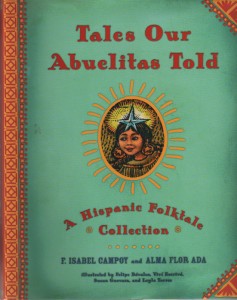 Tales Our Abuelitas Told: A Hispanic Folktale Collection is one of the many books you have written with Alma Flor Ada. Why do you think so many readers are drawn to your retellings of these particular folktales?
Tales Our Abuelitas Told: A Hispanic Folktale Collection is one of the many books you have written with Alma Flor Ada. Why do you think so many readers are drawn to your retellings of these particular folktales?
Authors love all their books, but there are some that connect with you in a very personal way. “Tales Our Abuelitas Told” was published the year I lost my mother. She was the greatest storyteller, imaginative, soft spoken, and these were tales
Add a CommentBlog: The Children's Book Review (Login to Add to MyJacketFlap)
JacketFlap tags: Author Showcase, Alma Flor Ada, Ages Nine to Twelve: Books for Third Through Sixth Grade, Cultural Wisdom: Books that teach, Hispanic Heritage, F. Isabel Campoy, Ages Four to Eight: Books for Pre-School Through Second Grade, Multicultural, Folktales, Picture Books, Add a tag
Author Showcase
By Isabel F. Campoy, for The Children’s Book Review
Published: September 29, 2011
 Tales Our Abuelitas Told: A Hispanic Folktale Collection
Tales Our Abuelitas Told: A Hispanic Folktale Collection
by F. Isabel Campoy and Alma Flor Ada
Atheneum. Simon & Schuster
Book overview: Once upon a time, in a land far away…
These stories have journeyed far—over mountains, deserts, and oceans—carried by the wind, passed on to us by our ancestors. Now they have found their way to you.
A sly fox, a bird of a thousand colors, a magical set of bagpipes, and an audacious young girl… A mixture of popular tales and literary lore, this anthology celebrates Hispanic culture and its many roots –Indigenous, African, Arab, Hebrew, and Spanish.
F. Isabel Campoy and Alma Flor Ada have retold twelve beloved stories that embody the lively spirit and the rich heritage of Latino people.
This unforgettable collection is highlighted by the work of four leading Latino artists: Felipe Dávalos, Viví Escrivá, Susan Guevara and Leyla Torres.
Awards
A Junior Library Guild Selection
Kirkus Reviews Best Books
A Parent’s Choice Recommended Book
Best Books of the Year, Notable Books for a Global Society – American Library Association
Best Folklore in Best Books of the Year, Nick Jr. Magazine
Featured Book of the Month, Colorín Colorado Website, American Federation of Teachers
List of Best Books for 2006, New York Public Library
Critical Acclaim
The introduction to this delightful collection explains clearly how stories develop and change over time; in fact, the two storytellers heard most of these amusing tales when they were children and have retold them many times since in their own unique styles. … Children will relish their humor, especially if read aloud, and teens will also enjoy this lively presentation. Traditional story beginnings and endings are provided in Spanish and translated into English … . Make room on your shelves for this excellent book. ~ School Library Journal
The authors celebrate Hispanic culture and its many roots–indigenous, African, Spanish, Arab, Hebrew–assembling tales from as far afield as Spain and Idaho, and showing how the tales have transformed and influenced one another, and even how Ada and Campoy have changed them. … The spacious book design will work well for both independent reading and reading aloud, and each story is illustrated with one or more full-page pictures in
Add a Comment
Blog: The Children's Book Review (Login to Add to MyJacketFlap)
JacketFlap tags: Courage, Encouragement, Books for Girls, Book Lists: Specialty picks, Eugene Yelchin, Dan Yaccarino, Cultural Wisdom: Books that teach, Picture Book - Wordless, Marissa Moss, Social Graces: Books with a Purpose, Ida Lewis, Ages Four to Eight: Books for Pre-School Through Second Grade, Andrea U’Ren, Mary Kuryla, Add a tag
By Nicki Richesin, The Children’s Book Review
Published: September 27, 2011
Sometimes our children need encouragement—especially when they’re feeling a little shy in a new environment. Let’s face it; sometimes we all need a little bolstering to confront new experiences. The following books may help your children do so with grace and boost their confidence. After all, offering gentle words of support can go a long way. Just ask Mr. Bear.
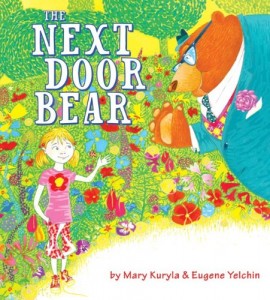 The Next Door Bear is the perfect book for a child who is just starting a new school or moving to a new neighborhood. When the playful children outside Emma’s new apartment are less than welcoming, she feels terribly lonely. Everything is blue in Yelchin’s painted illustrations, until Emma meets a debonair bear on the elevator. After Mr. Bear invites her to tea, Emma’s world becomes a technicolored rainbow of trees and flowers and she feels encouraged enough to try and make new friends. Together talented husband-and-wife duo Eugene Yelchin and Mary Kuryla have created a balm for children who must learn to overcome their fears. (Ages 5-8)
The Next Door Bear is the perfect book for a child who is just starting a new school or moving to a new neighborhood. When the playful children outside Emma’s new apartment are less than welcoming, she feels terribly lonely. Everything is blue in Yelchin’s painted illustrations, until Emma meets a debonair bear on the elevator. After Mr. Bear invites her to tea, Emma’s world becomes a technicolored rainbow of trees and flowers and she feels encouraged enough to try and make new friends. Together talented husband-and-wife duo Eugene Yelchin and Mary Kuryla have created a balm for children who must learn to overcome their fears. (Ages 5-8)
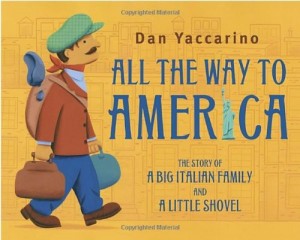 Dan Yaccarino recounts his big Italian family’s true immigration story in All The Way to America. His great-grandfather embarks on the great journey from Sorrento to Ellis Island with a handy shovel and these parting words of wisdom, “Work hard, but remember to enjoy life, and never forget your family.” Through four generations the shovel is industriously used in food stands and bakeries, for gardening and even to pour rock salt over snowy sidewalks. Now it resides safely perched on Yaccarino’s shelf, a proud reminder of how far his family has come and what they have achieved in their adopted home. (Ages 5-8)
Dan Yaccarino recounts his big Italian family’s true immigration story in All The Way to America. His great-grandfather embarks on the great journey from Sorrento to Ellis Island with a handy shovel and these parting words of wisdom, “Work hard, but remember to enjoy life, and never forget your family.” Through four generations the shovel is industriously used in food stands and bakeries, for gardening and even to pour rock salt over snowy sidewalks. Now it resides safely perched on Yaccarino’s shelf, a proud reminder of how far his family has come and what they have achieved in their adopted home. (Ages 5-8)
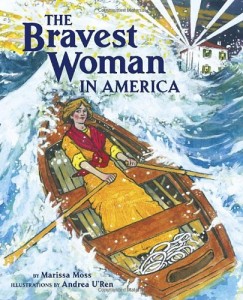 Ida Lewis was known as The Bravest Woman in America when she became the first woman to receive the American Cross of Honor. Determined to become a lighthouse keeper like her father, Ida learns “to pull her weight” by observing and following his careful instructions and courageous feats. Keeping watch over the harbor, young Ida rescues a boatload of boys whose sailboat capsizes. This beautifully written (by Marissa Moss) and illustrated (by Andrea U’Ren) book will light the way for brave girls to face their fears and reach for their aspirations. (Ages 5-8)
Ida Lewis was known as The Bravest Woman in America when she became the first woman to receive the American Cross of Honor. Determined to become a lighthouse keeper like her father, Ida learns “to pull her weight” by observing and following his careful instructions and courageous feats. Keeping watch over the harbor, young Ida rescues a boatload of boys whose sailboat capsizes. This beautifully written (by Marissa Moss) and illustrated (by Andrea U’Ren) book will light the way for brave girls to face their fears and reach for their aspirations. (Ages 5-8)
Add these books to your collection by clicking on the book cover images.
Nicki Richesin is the editor of four anthologies,W
Add a CommentBlog: The Children's Book Review (Login to Add to MyJacketFlap)
JacketFlap tags: Current Affairs, Don Brown, September 11, Ages Nine to Twelve: Books for Third Through Sixth Grade, Cultural Wisdom: Books that teach, Ages Four to Eight: Books for Pre-School Through Second Grade, Annie Thoms, Add a tag
By Bianca Schulze, The Children’s Book Review
Published: September 11, 2011
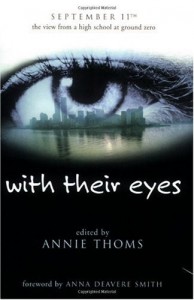 With Their Eyes: September 11th—The View from a High School at Ground Zero
With Their Eyes: September 11th—The View from a High School at Ground Zero
By Annie Thoms
Reading level: Ages 13 and up
Paperback: 256 pages
Publisher: HarperCollins; 1 edition (August 20, 2002)
Source: Publisher
Publisher’s synopsis: Tuesday, September 11, seemed like any other day at Stuyvesant High School, only a few blocks away from the World Trade Center. The semester was just beginning, and the students, faculty, and staff were ready to start a new year.
Within a few hours that Tuesday morning, they would experience an event that transformed all their lives completely.
Here, in their own words, are the firsthand stories of a day none of us will ever forget.
Add this book to your collection: With Their Eyes: September 11th—The View from a High School at Ground Zero
 America Is Under Attack: September 11, 2001: The Day the Towers Fell
America Is Under Attack: September 11, 2001: The Day the Towers Fell
By Don Brown
Hardcover: 64 pages
Publisher: Flash Point (August 16, 2011)
Source: Publisher
Publisher’s synopsis: On the ten year anniversary of the September 11 tragedy, a straightforward and sensitive book for a generation of readers too young to remember that terrible day.
The events of September 11, 2001 changed the world forever. In the fourth installment of the Actual Times series, Don Brown narrates the events of the day in a way that is both accessible and understandable for young readers. Straightforward and honest, this account moves chronologically through the morning, from the plane hijackings to the crashes at the World Trade Center, the Pentagon, and Pennsylvania; from the rescue operations at the WTC site to the collapse of the buildings. Vivid watercolor illustrations capture the emotion and pathos of the tragedy making this an important book about an unforgettable day in American history.
Add this book to your collection: America Is Under Attack: September 11, 2001: The Day the Towers Fell
©2011 The Childrens Book Review. All Rights Reserved.
. Add a CommentBlog: The Children's Book Review (Login to Add to MyJacketFlap)
JacketFlap tags: School, Grammar, Dictionaries, Gene Barretta, Ages Four to Eight: Books for pre-school to second grade, Ages Nine to Twelve: Books for Third Through Sixth Grade, Book Lists: Specialty picks, Cultural Wisdom: Books that teach, Steve Murrie, Matthew Murrie, Homographs, Add a tag
By Bianca Schulze, The Children’s Book Review
Published: September 2, 2011
From Dictionaries to a grammar guide to a book of homographs, the following list of books features some of our favorite school tools and brain ticklers…
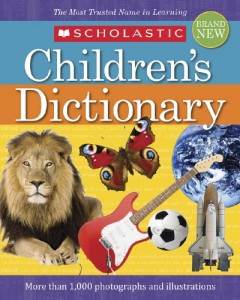 Scholastic Children’s Dictionary
Scholastic Children’s Dictionary
by Scholastic
Reading level: Ages 8 and up
Hardcover: 800 pages
Publisher: Scholastic Reference; New edition (July 1, 2010)
Source: Publisher
Publisher’s synopsis: The bestselling Scholastic Children’s Dictionary is brand new for 2010! Some of the outstanding new features include: brand new cover and interior design, more than 1,000 all new photographs and illustrations, and double the current number of word histories and sample sentences. New entries and definitions have been written by prominent lexicographers and reviewed by an advisory board of educators and librarians. Bonus material includes a thesaurus and specially commissioned endpaper maps.
With exciting new features, accessible definitions, and helpful illustrations and photographs throughout, the new Scholastic Children’s Dictionary is an essential resource that belongs in every home, classroom, and library.
Add this book to your collection: Scholastic Children’s Dictionary
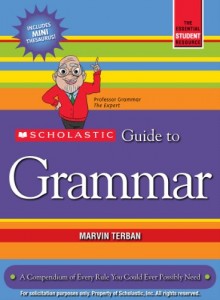 Scholastic Guide to Grammar
Scholastic Guide to Grammar
by Marvin Terban
Reading level: Ages 8 and up
Paperback: 256 pages
Publisher: Scholastic Reference; Student edition (August 1, 2011)
Source: Publisher
Publisher’s synopsis: The ultimate resource for proper grammar.
The SCHOLASTIC GUIDE TO GRAMMAR is an easy-to-use, color-coded, tabbed guide packed full of information, examples, and tips for English language arts success. Write a paper, meet new people, apply for a job, and more, with perfect grammar, spelling, and punctuation. Join “Professor Grammar” on this guided journey through the intricacies of the English language.
Add this book to your collection: Scholastic Guide to Grammar
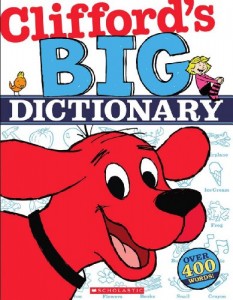
Clifford’s Big Dictionary
by Scholastic
Reading level: Ages 4 and up
Hardcover: 128 pages
Publisher: Cartwheel Books (July 1, 2011)
Source: Publisher
Publisher’s synopsis: The perfect back-to-school reference book for the early elementary set!
From Scholastic, the most trusted name in learning (R), comes this picture dictionary featuring America’s favorite big red dog, Clifford!
The 128-page dictionary
Add a CommentBlog: The Children's Book Review (Login to Add to MyJacketFlap)
JacketFlap tags: Bilingual, Cinco De Mayo, Alma Flor Ada, Rafael Lopez, Ages Four to Eight: Books for pre-school to second grade, Book Lists: Specialty picks, Cultural Wisdom: Books that teach, Picture Book - Wordless, Samantha R. Vamos, F. Isabel Campoy, Arthur Dorros, Rudy Gutierrez, Ulises Wensell, Add a tag
By Bianca Schulze, The Children’s Book Review
Published: May 4, 2011
To celebrate Cinco de Mayo, take a look at the bilingual books that we’ve been reading …
The Cazuela That the Farm Maiden Stirred
by Samantha R. Vamos (Author), Rafael Lopez (Illustrator)
Mama and Me
by Arthur Dorros (Author), Rudy Gutierrez (Illustrator)
Ten Little Puppies/Diez perritos
by Alma Flor Ada (Author), F. Isabel Campoy (Author), Ulises Wensell (Illustrator)
Blog: The Children's Book Review (Login to Add to MyJacketFlap)
JacketFlap tags: Chapter Books, Vietnam, Immigrants, Books for Girls, Alabama, Ages Nine to Twelve: Books for third through sixth grade, Poetry: Rhymes and verses, Cultural Wisdom: Books that teach, Thanhha Lai, Emigration and immigration, Vietnamese Americans, Add a tag
By Bianca Schulze, The Children’s Book Review
Published: April 26, 2011
by Thanhha Lai
Reading level: Ages 8-12
Hardcover: 272 pages
Publisher: HarperCollins (February 22, 2011)
Source: Publisher
What to expect: Vietnamese Americans, Emigration and immigration, Immigrants, Vietnam, Alabama
How much do we know about those around us? This is the question that debut novelist Thanhha Lai challenges her readers with.
Based on Lai’s own personal experience as a Vietnamese refugee, Inside Out & Back Again is a poignant story divided into four parts using a series of poems that chronicle the life of 10-year-old Hà, a child–refugee from Vietnam, during the year 1975—the Fall of Saigon. Along with her mother and three brothers (her father has been missing in action for nine years), Hà travels by boat to a tent city in Guam, is moved to Florida and then finds herself living in Alabama sponsored by an “American cowboy” and his wife. In Alabama, the family are treated as outcasts and forced to integrate quickly through language, food, and religion, to be accepted as a part of the community.
Adjustments to Hà’s new life are delivered through smells and tastes and touch. In “Part One: Saigon,” a verse titled “Two More Papayas” gives Hà’s delectable description of her most cherished fruit. In “Part Three: Alabama,” a verse titled “Not the Same,” which is followed by “But Not Bad,” showcases the bitter differences between the comfort of her precious birth city and the emotional challenges of her new home in Alabama, combined with the acceptance of change.
Two More Papayas
“…Middle sweet
between a mango and a pear.Soft as a yam
gliding down
after three easy,
thrilling chews.”
Not the Same
“Three pouches of papaya
dried papaya
Chewy
Sugary
Waxy
Sticky
Not the same
at all.
So mad,
I throw all in the trash.”
But Not Bad
“… I wake up at faint light,
guilt heavy on my chest.
I head toward the trash can.
Yet
on the dining table
on a plate
sit strips of papaya
gooey and damp,
having been soaked in hot water.
The sugar has melted off
leaving
plump
moist
chewy
bites.
Hummm …
Not the same,
but not bad
at all.”
Told with pure honesty, emotions run freely from verse to verse and page to page. Hà’s voice is clear, allowing readers to make a leap from sympathy to deep seeded empathy by experiencing her joy, pain, anger, frustration, loyalties, challenges, loss, and determination. The clarity of Hà’s self-awareness and development toward self-actualization is reminiscent of Susan Patron’s character Lucky, also a 10-year-old girl, from the Newbery winner (2007) The Higher Power of Lucky (2006). Both characters suffer
Add a CommentBlog: The Children's Book Review (Login to Add to MyJacketFlap)
JacketFlap tags: Amelia Earhart, Books for Girls, Jennifer Fosberry, Mike Litwin, Audrey Hepburn, Candace Fleming, Ages Four to Eight: Books for pre-school to second grade, Ages Nine to Twelve: Books for third through sixth grade, Teens: Books for young adults, Book Lists: Specialty picks, Cultural Wisdom: Books that teach, Julia Denos, Anjelica Huston, Margaret Cardillo, John Miller, Add a tag
By Bianca Schulze, The Children’s Book Review
Published: March 8, 2011
Our shared history unites families, communities, and nations. Although women’s history is intertwined with the history shared with men, several factors – social, religious, economic, and biological – have worked to create a unique sphere of women’s history. ~ The National Women’s History Project
by Margaret Cardillo (Author), Julia Denos (Illustrator)
Reading level: Ages 4-8
Hardcover: 32 pages
Publisher: Balzer + Bray (January 25, 2011)
Source: Publisher
From her life as a child in Nazi occupied Europe to her rise to fame as an actress to her empowering work with UNICEF, Hepburn’s kindness and compassion has been highlighted clearly and carefully and will most definitely inspire young girls. The beautifully painted artwork truly captures the eloquence and signature style that exuded from Hepburn her entire life. Just Being Audrey certainly has a special je ne sais quoi.
Add this book to your collection: Just Being Audrey
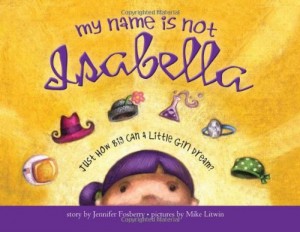 My Name Is Not Isabella: Just How Big Can a Girl Dream
My Name Is Not Isabella: Just How Big Can a Girl Dream
by Jennifer Fosberry (Author), Mike Litwin (Illustrator)
Reading level: Ages 4-8
Hardcover: 32 pages
Publisher: Sourcebooks Jabberwocky; Reprint edition (September 1, 2010)
Source: Publisher
This picture book is a brilliant way to introduce young girls to some very wonderful women. It’s empowering and inspiring and a whole lot of fun. These are some of Isabella’s role models: U.S. Astronaut Sally Ride, activist Rosa Parks, and sharpshooter Annie Oakley.
Add this book to your collection: My Name Is Not Isabella: Just How Big Can a Girl Dream
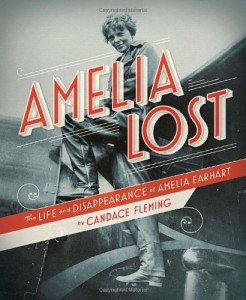 Amelia Lost: The Life and Disappearance of Amelia Earhart
Amelia Lost: The Life and Disappearance of Amelia Earhart
by Candace Fleming
Reading level: Ages 8-12
Hardcover: 128 pages
Publisher: Schwartz & Wade (February 8, 2011)
Source: Publisher
Candace Fleming is a non-fiction writing master. There are many books about Amelia Earhart that have been written for children, howev
Add a CommentBlog: The Children's Book Review (Login to Add to MyJacketFlap)
JacketFlap tags: Black History Month, Books for Boys, Ages Four to Eight: Books for pre-school to second grade, Cultural Wisdom: Books that teach, Picture Book - Wordless, Kristin Blackwood, Mike Blanc, Vanita Oelschlager, Add a tag
By Tina Vasquez, for The Children’s Book Review
Published: February 7, 2011
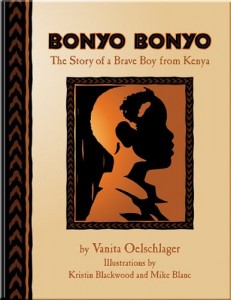 Bonyo Bonyo: The True Story of a Brave Boy from Kenya
Bonyo Bonyo: The True Story of a Brave Boy from Kenya
By Vanita Oelschlager (Author), Kristin Blackwood and Mike Blanc (Illustrators)
Reading level: Ages 4-8
Paperback: 42 pages
Publisher: Vanita Books (April 1, 2010)
Source: Publisher
Bonyo Bonyo: The True Story of a Brave Boy from Kenya is a must-read for every American child. In the land of plenty, it’s vital to remind yourself and your children of how lucky they are to live in a country where education is considered a human right. Bonyo Bonyo is the moving story of real life Dr. Bonyo and his dream of becoming a doctor, as told by Bonyo himself to author Vanita Oelschlager.
Despite overcoming extraordinary circumstances and unbelievable hardships, Bonyo’s story is relayed in a way not intended to illicit sympathy. The young boy’s experiences are related rather matter-of-factly, giving the impression that it went without question that Bonyo would do whatever necessary to obtain an education.
Growing up in Western Kenya in a family of struggling farmers, Bonyo enjoyed the simple things in life and was a happy child, but it was the death of his sister when Bonyo was nine that forever changed the path his life would take. Akinyi, Bonyo’s sister, died because his village did not have access to clean water or medical care. From that day forward Bonyo swore that he would grow up to put a hospital in his village to help other children like Akinyi.
The problem was that Bonyo’s family could not afford the dollar it would cost to send him to school that year, but a chance encounter with the principal of a school sends Bonyo on an amazing lifelong journey. Eventually, he would find himself at medical school in Texas with a blanket and $11 in his pocket and years later, he would fulfill his lifelong dream.
Bonyo’s emotional journey is only made more beautiful by the illustrations of Kristin Blackwood and Mike Blanc, whose striking artwork will take your breath away. Portions of the book are in vivid, bold colors, while other portions only feature daring black and white silhouettes— though all of it is amazing.
Vanita Oelschlager’s book dedication is the perfect summation of Bonyo’s story and a reminder of the millions like him “whose dreams brought them to America with the promise they might be fulfilled.”
Add this book to your collection: Bonyo Bonyo
Have you read this book? Rate it:
Note: There is a rating embedded within this post, please visit this post to rate it.
Blog: The Children's Book Review (Login to Add to MyJacketFlap)
JacketFlap tags: Chinese New Year, Ying-Hwa Hu, Cornelius Van Wright, Grace Lin, Eric Rohmann, Amy Krouse Rosenthal, Tom Lichtenheld, Tao Nyeu, Ages Four to Eight: Books for pre-school to second grade, Book Lists: Specialty picks, Cultural Wisdom: Books that teach, Picture Book - Wordless, Seasonal: Holiday Books, Year of the Rabbit, Clare Turlay Newberry, Diane Hoyt-Goldsmith, Hingman Chan, Karen Chinn, Lawrence Migdale, Marcia K. Vaughan, Add a tag
By Bianca Schulze, The Children’s Book Review
Published: January 31, 2010
This year, Chinese New Year falls on February 3, 2011. It is the Year of the Rabbit—the fourth animal in the 12-year cycle of the Chinese zodiac. The rabbit represents hope, and it is widely shared that “People born under the sign of the rabbit are gentle, sensitive, modest, and merciful and have strong memory. They like to communicate with others in a humorous manner. They cannot bear dull life, so they are good at creating romantic or interesting spice…”
The picture books listed below, offer solid introductions into the Chinese New Year and are then followed by some good-old bunny tales to celebrate the Year of the Rabbit.
by Grace Lin
Reading level: Ages 4-8
Hardcover: 34 pages
Publisher: Knopf Books for Young Readers (January 8, 2008)
Publisher’s synopsis: This exuberant story follows a Chinese American family as they prepare for the Lunar New Year. Each member of the family lends a hand as they sweep out the dust of the old year, hang decorations, and make dumplings. Then it’s time to put on new clothes and celebrate with family and friends. There will be fireworks and lion dancers, shining lanterns, and a great, long dragon parade to help bring in the Lunar New Year. And the dragon parade in our book is extra long–on a surprise fold-out page at the end of the story. Grace Lin’s artwork is a bright and gloriously patterned celebration in itself! And her story is tailor-made for reading aloud.
Add this book to your collection: Bringing in the New Year
by Diane Hoyt-Goldsmith (Author), Lawrence Migdale (Photographer)
Reading level: Ages 4-8
Paperback: 32 pages
Publisher: Holiday House (October 1999)
Source: Library
Publisher’s synopsis: A Chinese-American boy’s family observes a cherished tradition.
Add this book to your collection: Celebrating Chinese New Year
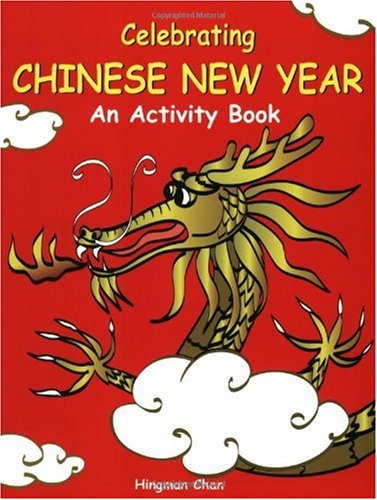 Celebrating Chinese New Year: An Activity Book
Celebrating Chinese New Year: An Activity Book
by Hingman Chan
Reading level: Ages 9-12
Paperback: 32 pages
Publisher: Asia for Ki
Add a CommentBlog: The Children's Book Review (Login to Add to MyJacketFlap)
JacketFlap tags: Money, Ages Four to Eight: Books for pre-school to second grade, Cultural Wisdom: Books that teach, Devon Kinch, Interviews, Add a tag
By Devon Kinch, for The Children’s Book Review
Published: January 27, 2011
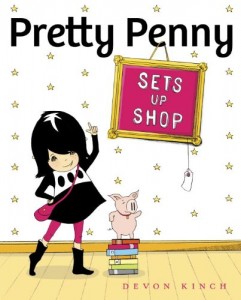 The Spirit of Pretty Penny
The Spirit of Pretty Penny
The Pretty Penny series became the subject of my thesis while a graduate student in graphic design. I had put off my graduate education until I could afford it – which wasn’t until I hit thirty years old. I spent the better part of my twenties getting my personal finances in order after digging myself out of credit card debt.
The experience of repairing my finances – which is a fancy way of saying I worked two jobs and slowly chipped away at the debt – was transformative. I couldn’t believe I had gotten myself into this kind of trouble. I had a lot of girlfriends who were in the exact same boat, so I set out to create a website and line of products to support thirty-somethings in the repair of their finances. However, as I dug deeper into my research, I discovered that the most effective place to start talking about money was with children. Suddenly, my thesis work underwent a dramatic transformation.
Financial experts say that you can begin teaching a child about money as soon as they can differentiate between a nickel and a dime. So what’s the best way to talk to kids as young as four years old about money? I needed a fun and relatable character to spearhead the mission. My childhood heroines were Punky Brewster, Pippi Longstocking and Annie. All three were smart, edgy, and fearlessly independent young girls. They had their own unique style and attitude that endeared me to them. (They also had totally awesome theme songs, but that’s besides the point.) I wanted Penny to embody the spirit of my childhood idols, but be very much a modern girl of today.
In each book, Penny takes her readers on new adventures by way of the Small Mall. She will reuse old objects to create new shops, she’ll curate exhibitions, print her own newspaper, direct a film, open a puppy dog beauty salon, and sell original one-of-a-kind creations to her friends and neighbors. She is a true mini-entrepreneur: passionate and resourceful. All the while, she will tackle various financial topics like earning, saving, investing, working with coupons, and understanding advertising. The more emotional aspects of money like stealing, fighting about money, overspending, and need vs. wants will also be explored. Penny will investigate these topics with humor, style, and that can-do spirit that Pippi, Punky and Annie were famous for.
Blog: The Children's Book Review (Login to Add to MyJacketFlap)
JacketFlap tags: Latino, Peter Sis, David Diaz, Margarita Engle, Carmen Tafolla, Pura Belpré Award, Pam Munoz Ryan, George Ancona, Award Winners: Books with honors, Cultural Wisdom: Books that teach, Eric Velasquez, Amy Novesky, Amy Cordova, Duncan Tonatiuh, Enrique Flores-Galbis, Add a tag
By Bianca Schulze, The Children’s Book Review
Published: January 10, 2011
As announced by the American Library Association (ALA) …
Pura Belpré (Author) Award
Honoring a Latino writer whose children’s books best portray, affirm and celebrate the Latino cultural experience:
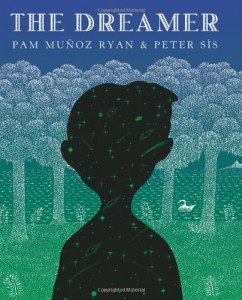
“The Dreamer,” written by Pam Muñoz Ryan, is the 2011 Belpré Author Award winner. The book is illustrated by Peter Sís and published by Scholastic Press, an imprint of Scholastic Inc.
Three BelpréAuthor Honor Books were named:
“¡Olé! Flamenco,” written and illustrated by George Ancona and published by Lee & Low Books Inc.; “The Firefly Letters: A Suffragette’s Journey to Cuba,” written by Margarita Engle and published by Henry Holt and Company, LLC; and “90 Miles to Havana,” written by Enrique Flores-Galbis and published by Roaring Brook Press, a division of Holtzbrinck Publishing.
Pura Belpré (Illustrator) Award
Honoring a Latino illustrator whose children’s books best portray, affirm and celebrate the Latino cultural experience:
“Grandma’s Gift,” illustrated and written by Eric Velasquez, is the 2011 Belpré Illustrator Award winner. The book is published by Walker Publishing Company, Inc., a division of Bloomsbury Publishing, Inc.
Three Belpré Illustrator Honor Books for illustration were selected:
“Fiesta Babies,” illustrated by Amy Córdova, written by Carmen Tafolla and published by Tricycle Press, an imprint of the Crown Publishing Group, a division of Random House, Inc.; “Me, Frida,” illustrated by David Diaz, written by Amy Novesky and published by Abrams Books for Young Readers, an imprint of ABRAMS; “Dear Primo: A Letter to My Cousin,” illustrated and written by Duncan Tonatiuh and published by Abrams Books for Young Readers, an imprint of ABRAMS.
Add a Comment
Blog: The Children's Book Review (Login to Add to MyJacketFlap)
JacketFlap tags: R.G. Roth, Richard Michelson, Books for Boys, Ages Four to Eight: Books for pre-school to second grade, Ages Nine to Twelve: Books for third through sixth grade, Cultural Wisdom: Books that teach, Picture Book - Wordless, Add a tag
By Phoebe Vreeland, The Children’s Book Review
Published: January 10, 2010
by Richard Michelson (Author), R. G. Roth (Illustrator)
Reading level: Ages 6-10
Hardcover: 32 pages
Publisher: Knopf Books for Young Readers (May 11, 2010)
Source: Publisher
Busing Brewster is a book about believing in one’s self, making friends across the barriers of race and the power of strong women in the lives of children—all themes that author Richard Michelson has written about before. The subject of this recent book is desegregation busing in Boston during the 1970’s. Michelson says he doesn’t aim at a particular reader, but relies upon the publisher to tell him what age his books are geared to. Knopf has targeted this book at ages 6-10, proving that, even after children have learned to read, picture books are still relevant. Michelson is a great believer in the value of visual literacy and a true spokesperson for picture books. He considers book illustrations fine art and his art gallery in Northampton, Massachusetts recently hosted the 21st Annual Children’s Illustration Show.
As a child growing up in a fairly poor Brooklyn neighborhood, racial issues were important to Michelson and have stayed near to his heart. His 2006, book Across the Alley tells of a friendship between a Jewish boy and his African-American neighbor. In 2008, his book, As Good as Anybody, about the friendship between Martin Luther King, Jr. and Abraham Joshua Heschel—a Polish rabbi who joined the Selma march—received starred reviews and won the Sydney Taylor Award Gold Medal.
Busing Brewster is told from the perspective of a six year-old boy who, along with his older brother Bryan, will be bused to an all white school an hour away. From the first page, Brewster’s challenges and support are neatly presented. The chain link fence he must scale to enter the playground is juxtaposed against the arms of his brother Bryan who reaches to catch him. The elements of family, community and familiarity are crucial. Thankfully, Brewster flies beneath the radar of racism somewhat, protected by his age, his brother, and the fact that he can’t read yet. His mother views busing as an opportunity to support the potential she sees in her sons and is encouraged by Central’s facilities: a proper library, art and music classes and a swimming pool. Brewster is buoyed up by his mother’s optimism and goes to bed with anticipation. His brother Bryan goes to bed beating his pillow, dreading rising early for the long bus ride and confronting the discrimination.
The next day, their bus is greeted by picketing adults and unwelcoming school children. Brewster takes a drink from the fountain, a boy shoves him and a fight ensues when Bryan intervenes. All three boys are sent to the library for a day of detention. They soon befriend a white boy whom they call Freckle-face. We see young Brewster’s ability to find similitude. Freckle-face’s laugh reminds him of neighborhood friend Big Earl. He imagines the librarian Miss O’Grady lo
Add a CommentBlog: The Children's Book Review (Login to Add to MyJacketFlap)
JacketFlap tags: Lori Mortensen, Raul Allen, Science, Books for Boys, Ages Four to Eight: Books for pre-school to second grade, Ages Nine to Twelve: Books for third through sixth grade, Cultural Wisdom: Books that teach, Picture Book - Wordless, Add a tag
By Tina Vasquez, for The Children’s Book Review
Published: December 5, 2010
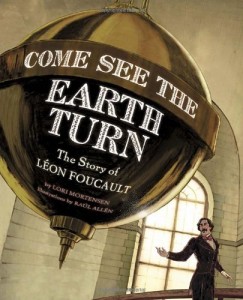 Come See the Earth Turn: The Story of Léon Foucault
Come See the Earth Turn: The Story of Léon Foucault
By Lori Mortensen (Author), Raul Allen (Illustrator)
Reading level: Ages 7-9
Hardcover: 32 pages
Publisher: Tricycle Press (September 14, 2010)
Source: Publisher
In Come See the Earth Turn we immediately learn that physicist Jean Bernard Léon Foucault was special from the very beginning, but not in the way you might think. He was a small, sickly baby who turned into an introverted, slow-moving boy and because of his rocky start in life, many were surprised by his talent for building clever and inventive contraptions. At the urging of his mother, Léon enrolled in medical school with the hope of fulfilling his mother’s dream for him to become a surgeon, but the profession did not sit well with Léon and he eventually dropped out. It wasn’t a total waste however, because it was in the labs at his school that the young man discovered his true passion: physics.
As young readers will learn in Come See the Earth Turn, there are many reasons Léon is an important part of history. Not only was he the first person to photograph the sun, but he was also the first to accurately measure the speed of light. His most important discovery; however, was the result of a happy accident in his laboratory and it once and for all proved that the earth spins on an axis, a claim that had been disputed for years by scholars, scientists, and other educated people of the time.
Part history lesson and part children’s book, Come See the Earth Turn puts complicated science into its simplest terms and sheds light on how Léon created his world famous Foucault pendulum, an invention that would prove to the general public and his critics that the earth rotated.
Young readers will find the realistic illustrations captivating, while also learning the story of Léon Foucault, an unlikely genius.
Add this book to your collection: Come See the Earth Turn
Blog: The Children's Book Review (Login to Add to MyJacketFlap)
JacketFlap tags: Author Interviews, India, Author Showcase, Cultural Wisdom: Books that teach, Monika Schröder, Travel, Add a tag
By Bianca Schulze, The Children’s Book Review
Published: November 10, 2010
TCBR: Saraswati’s Way, is your second published novel. It’s set in India, where you currently live. Tell us about the book and its main character, 12-year-old Akash.
Monika Schröder: The book tells the story of 12-year old Akash, from the rural northern Indian state of Rajasthan. He has a gift for math. Numbers line up in his head easily, arrange themselves in patterns, and move in formations. In order to develop his gift for numbers Akash wants to go to a school in the city. But Akash’s family is poor and doesn’t understand his longing for learning. He prays to the Hindu gods Ganesh and Saraswati. When circumstances become so dire that his dream seems forever unattainable he makes an extreme decision, and runs away. After an adventurous train ride, he ends up in the New Delhi station, where he joins a gang of street kids. Finally, with the help of a newspaper vendor he learns that Saraswati will only help him if he deserves it.
TCBR: How did you develop the idea for this book?
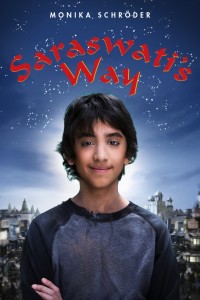 MS: By the time I started SARASWATI I had already lived in New Delhi for six years and knew that my next book would take place in India. Most contemporary fiction for children set in India has female protagonists but I wanted to write about a boy. To learn more about the street children who end up in the New Delhi train station I went to the Salaam Baalak Trust, an NGO that works with these kids. Here I listened to some of the children’s stories and tried to imagine what circumstances forced them to leave their families and to embark on an often dangerous journey to New Delhi. So I wanted to explore how a young Indian boy can find the strength to overcome his fear in pursuit of something he wants desperately.
MS: By the time I started SARASWATI I had already lived in New Delhi for six years and knew that my next book would take place in India. Most contemporary fiction for children set in India has female protagonists but I wanted to write about a boy. To learn more about the street children who end up in the New Delhi train station I went to the Salaam Baalak Trust, an NGO that works with these kids. Here I listened to some of the children’s stories and tried to imagine what circumstances forced them to leave their families and to embark on an often dangerous journey to New Delhi. So I wanted to explore how a young Indian boy can find the strength to overcome his fear in pursuit of something he wants desperately.
TCBR: What were the challenges you faced while writing this book?
MS: I grew up in Germany, a predominantly protestant country, where in school I learned bible stories and went to protestant confirmation at the age of 15. Writing about a Hindu boy was the biggest challenge while working on SARASWATI’S WAY. By the time I started the book I had traveled to Rajasthan several times so I knew the setting. Though I never became fluent I have also taken Hindi classes for four years and my Hindi teacher, whom the book is dedicated to, taught me a lot about religious customs and festivals. While writing the book I frequently asked her and other Indian friends if my depictions of a particular event were correct. One of the most challenging scenes to write was the funeral for Akash’s father. I have never attended a Hindu funeral and relied completely on the description given by Indian friends and col
Add a CommentBlog: The Children's Book Review (Login to Add to MyJacketFlap)
JacketFlap tags: Maneki Neko, Japan, Cats, Animals, Susan Lendroth, Ages Four to Eight: Books for pre-school to second grade, Cultural Wisdom: Books that teach, Kathryn Otoshi, Picture Book - Wordless, Add a tag
By Phoebe Vreeland, The Children’s Book Review
Published: November 6, 2010
 Maneki Neko: The Tale of the Beckoning Cat
Maneki Neko: The Tale of the Beckoning Cat
by Susan Lendroth (Author), Kathryn Otoshi (Illustrator)
Reading level: Ages 4-8
Hardcover: 32 pages
Publisher: Shen’s Books (July 19, 2010)
Source: Publisher
The ceramic statue of Maneki Neko, that plump white and black cat with one raised paw, is a well known symbol of luck and prosperity in Japanese culture. Susan Lendroth’s picture book Maneki Neko tells a tale of the origin of this lucky charm. In beautifully descriptive prose seasoned with a handful of familiar Japanese words, Lendroth takes us to another time and culture.
Kathryn Otoshi’s exquisite illustrations depict feudal Japan and a tiny hilltop monastery where a poor monk takes in a scrawny cat. The two survive on companionship and alms from the village below. One night during a terrible storm, the cat’s beckoning paw guides a samurai to the safety of the monastery and saves his life. In gratitude, the noble samurai transforms the monastery into a well endowed temple. The cat fattens, the tale travels, and a legend is born. Even the villagers benefit as they craft and sell ceramic charms to welcome good fortune.
Otoshi’s beautifully hued drawings are evocative of Japanese wood block prints. Her choice of color to establish a time, a season and place is perfect. Shades of magenta and lavender bring across the serenity of the temple. The lively village scenes are painted in vibrant tints and the violence of the tempest is colored in deep indigos and grays.
Maneki Neko is published by Shen’s Books, a publishing house with a focus on books that celebrate diversity and promote tolerance while introducing children to the cultures of Asia.
Not a cat lover? Check out Lendroth’s other recently released book Calico Dorsey, Mail Dog of the Mining Camps illustrated by the talented Adam Gustavson. Don’t miss Kathryn Otoshi’s deceptively simple award-winning book One—her fine talent has been noted. If you’re already a fan, you’ll be pleased to know Zero has just been released.
Add this book to your collection: Maneki Neko: The Tale of the Beckoning Cat
How do you rate this book?
Note: There is a rating embedded within this post, please visit this post to rate it.Blog: The Children's Book Review (Login to Add to MyJacketFlap)
JacketFlap tags: Claude Monet, Jos. A. Smith, P.I. Maltbie, Art, Ages Four to Eight: Books for pre-school to second grade, Cultural Wisdom: Books that teach, Picture Book - Wordless, Add a tag
By Tina Vasquez, for The Children’s Book Review
Published: September 29, 2010
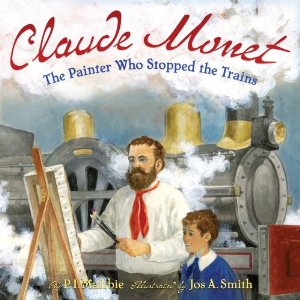 Claude Monet: The Painter Who Stopped the Trains
Claude Monet: The Painter Who Stopped the Trains
By P.I. Maltbie (Author), Jos. A. Smith (Illustrator)
Reading Level: Ages 5-9
Hardcover: 29 pages
Publisher: Abrams Books for Young Readers (2010)
Source: Publisher
It’s difficult to imagine a time when paintings of a train station could illicit outrage and be considered cutting edge, but in 1800’s Paris artist Claude Monet created quite a stir when in 1877 he painted a series of pictures of the Gare Saint-Lazare, a Paris train station.
As young readers will discover, Monet was a founding member of the impressionist movement, characterized by their bright strokes of color and their focus on everyday scenes rather than events from history, myth, or legend. This is where the controversy comes in, as the focus on modern life was very new and unfamiliar at the time to the public and the critics alike.
At first many were critical of Monet’s artistic style, but it was his train portraits that gained him acclaim and acceptance and in Claude Monet: The Painter Who Stopped the Trains, we learn how the initial inspiration for his series of portraits came from his young son Jean.
This story is as interesting as it is educational and young readers will first be drawn in by the beautiful artwork, but then stay for the story of Monet’s trains.
Add this book to your collection: Claude Monet: The Painter Who Stopped the Trains
Blog: The Children's Book Review (Login to Add to MyJacketFlap)
JacketFlap tags: Tad Hills, Ages Four to Eight: Books for pre-school to second grade, Cultural Wisdom: Books that teach, Picture Book - Wordless, Featured Videos, Add a tag
Add this book to your collection: How Rocket Learned to Read by Tad Hills
©2010 The Childrens Book Review. All Rights Reserved.
. Share and Enjoy:





 Add a Comment
Add a Comment
Blog: The Children's Book Review (Login to Add to MyJacketFlap)
JacketFlap tags: Books for Girls, Independence Day, Candace Fleming, Ages Four to Eight: Books for pre-school to second grade, Book Lists: Specialty picks, Seasonal: Holiday Events, Cultural Wisdom: Books that teach, Picture Book - Wordless, M. P. Hueston, Dance, Add a tag
July 4th is upon us again. This years Independence Day book selections are both lively and rich in heritage. Don’t be afraid to take a story-time break from all of the festivities—it might just be the thing that gets you and your family all the way through to the fireworks!
by Candace Fleming
Reading level: Ages 4-8
Hardcover: 40 pages
Publisher: Schwartz & Wade (October 13, 2009)
Source: Publisher
What to expect: Self-reliance, United States history
Imogene loves history. So much so, she quotes famous people (Davy Crockett, Abraham Lincoln, Eleanor Roosevelt—to name just a few) and has been doing this since she was a baby. These famous quotes help carry the story of Imogene’s discovery of an abandoned Historical Society building in her quiet, New Hampshire based town. She takes it upon herself to clean up and restore this historic gem and open it up for tours. Unfortunately, no one comes. Then, the icing on the cake, she finds out that the building will be demolished and replaced with a shoelace factory— a factory, that according to the town’s people, will put them on the map. Just when things look bleak, she discovers a letter written by George Washington that states that he had slept in the very building that was about to be torn down. The story peaks with self-reliance and perseverance as Imogene notifies a historian and then takes her stand on the front porch of the building, blocking the way of the wrecking trucks. The town’s people end up joining the crusade and the historian turns up with the President—who happens to be depicted as an African-American woman—and Imogene gets to save the building.
Candace Fleming has written a clever and engaging story that will appeal to both boys and girls. And, I have to say, it’s always a pleasure to read books that showcase girls with a strong sense of self. The illustrations, which are rendered in pen-and-ink and digital media, really add an authentic tone to the story—as well as a touch of humor. It’s really a great, little, history-lesson conversation starter. Different facts will interest different kids depending on their age and the previous introductions they’ve had to history; however, putting aside the historical emphasis, it’s an engaging and entertaining story.
Add this book to your collection: Imogene’s Last Stand
 The All-American Jump and Jive Jig
The All-American Jump and Jive Jig
by M. P. Hueston
Reading level: Ages 4-8
Hardcover: 24 pages
Publisher: Sterling (June 1, 2010)
Source: Publisher
What to expect: Rhyme, Dance, United States
This selection is all about energy and vibe. Using dance, author M. P. Hueston bands the people of the United States together. Each mentioned state has i
Add a CommentBlog: The Children's Book Review (Login to Add to MyJacketFlap)
JacketFlap tags: Ages Nine to Twelve: Books for third through sixth grade, Book Lists: Specialty picks, Cultural Wisdom: Books that teach, Add a tag
Two books that tackle the topic of self-discovery from a Native American point of view. They are geared to older children and pre-teens and the lessons they impart are valuable and timeless.
Add a CommentBlog: The Children's Book Review (Login to Add to MyJacketFlap)
JacketFlap tags: Current Affairs, Jesse Joshua Watson, Social Graces: Books with a practical use, Cultural Wisdom: Books that teach, Featured Videos, Add a tag
View Next 14 Posts









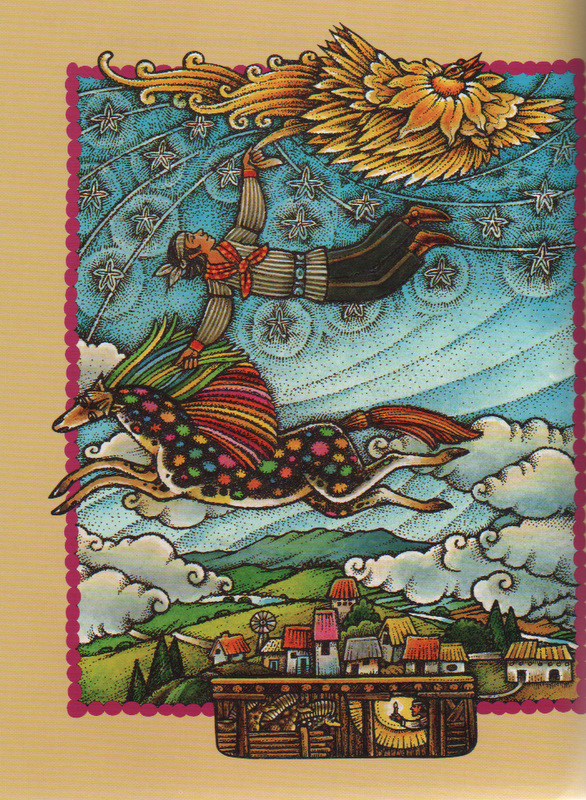
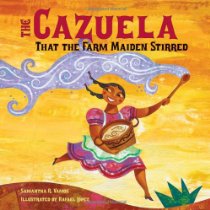
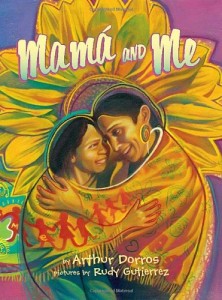
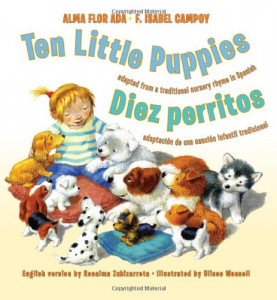
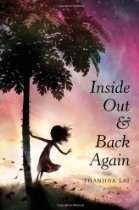
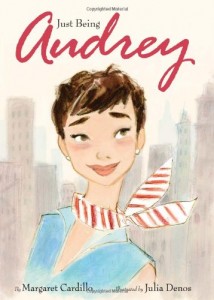
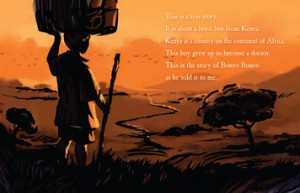
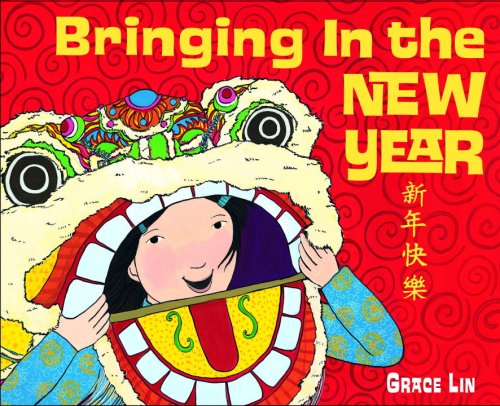

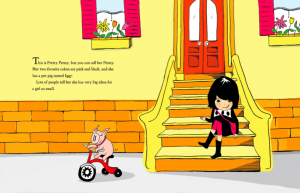
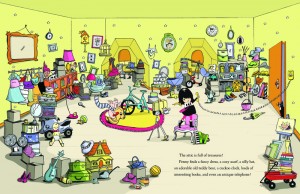
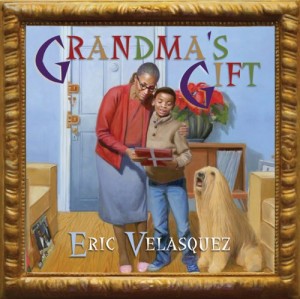
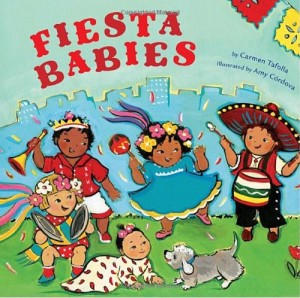
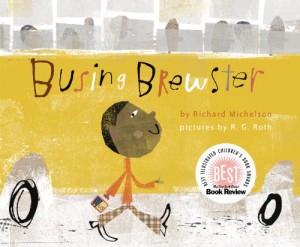

 Imogene’s Last Stand
Imogene’s Last Stand